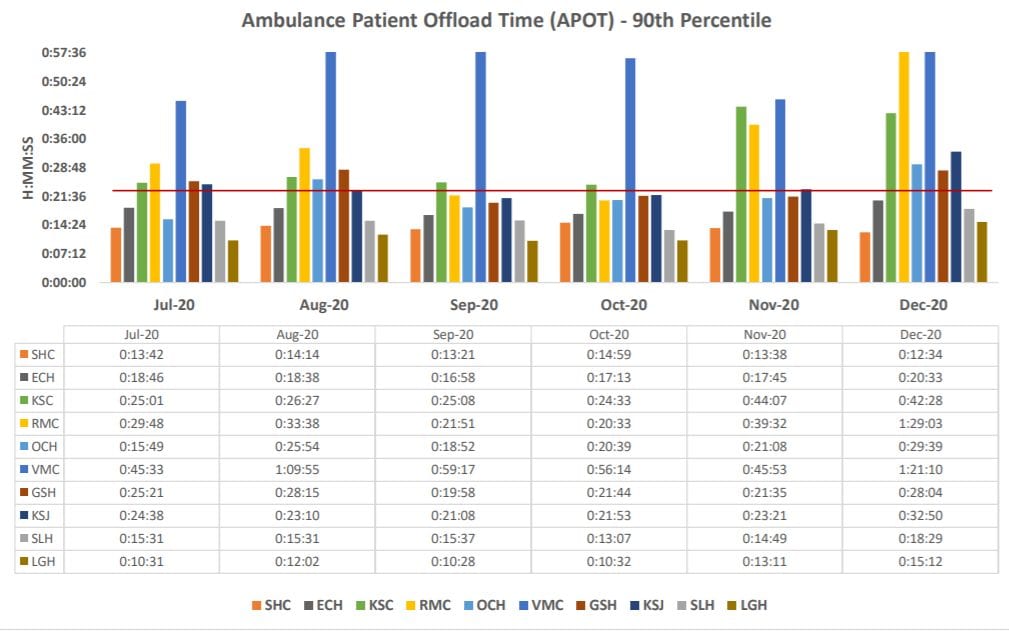The rise in COVID-19 cases isn’t just straining hospitals — it’s also taking a toll on the county’s 911 system.
Santa Clara County officials on Wednesday shared a sobering picture of Silicon Valley’s ambulance system crumbling under the pressures of the pandemic.
“Our health care system is inundated with patients. This also includes our 911 system and how it’s impacting us,” said Daniel Franklin, the county’s EMS duty chief, during a briefing. “We have less beds available to transition people from ambulances to the emergency room. What this means is we have less experienced ambulances available in our system because they’re currently waiting at hospitals.”
Patient offload times have steadily climbed since July, according to a county report, reaching record highs at hospitals such as Valley Medical Center and Regional Medical Center in December. Some patients were waiting more than an hour and a half to get a bed inside the hospitals, the report shows.


Franklin said it’s far worse than that.
“The wait times are anywhere between an additional 30 minutes to a case that took 8 hours to offload one patient,” he said. “It fluctuates based on time of day and what hospitals are experiencing.”
The county’s 911 center received 350 to 400 requests per day in December. Local ambulances transport 230 people each day.
But a third of those calls get canceled — meaning the patient does not get transported to the hospital. Franklin urged residents to reduce the strain by calling 911 only when it’s a life-threatening emergency and using urgent care centers for less serious issues.
The strain on the ambulance system comes as the county grapples with an all-time high of new COVID-19 cases and hospitalizations. California Gov. Gavin Newsom on Dec. 3 issued a new stay at home order for counties whose ICU capacity falls below 15%.
That order, which was set to expire this week, will likely be extended in the Bay Area, said County Counsel James Williams.
Under the order, barbershops, nail salons, personal care services, movie theaters, museums, bars and wineries must close. Retail can continue doing business at 20% capacity and restaurants can only serve take-out and delivery.
“We have every expectation that it will be extended here in the Bay Area as well because the hospitalization situation has not improved,” Williams said.
Right now, health officials said they’re seeing a surge in coronavirus cases likely tied to Thanksgiving festivities. As of Jan. 5, the county recorded 76,235 total COVID-19 cases and 771 deaths.
But as bad as things seem, health leaders are worried it can get worse. They’re fearing the spike next week from people gathering over Christmas and New Year’s Eve.
In October, the county was hovering around 4 to 5 COVID-19 cases per 100,000 residents. Now, officials said, it is well over 50.
“January is by far the most challenging month we have,” said Dr. Ahmad Kamal, Santa Clara County director of health care preparedness. “As awful as it is, it could get worse. And there’s no other way to say that. Right now we haven’t been in a situation where there are two people gasping for breath and there’s just one ventilator. We could get there.”
Jeff Chien, Valley Medical Center’s director of emergency services, said hospitals are being forced to get “creative” with where they’re putting patients. Some patients are being left on gurneys when they should be inside an ICU room.
“The ER is full. Folks are waiting for beds,” he said. “We are getting very creative with places to see patients and patients are struggling. Some folks look like they are drowning while they are sitting in bed in front of us.”
Chien said the message is clear — residents need to mask up, socially distance and only call 911 when it’s a critical emergency.
“I’m begging everyone to help us out because we’re not the front line,” he said. “We’re the last line.”



Leave a Reply
You must be logged in to post a comment.